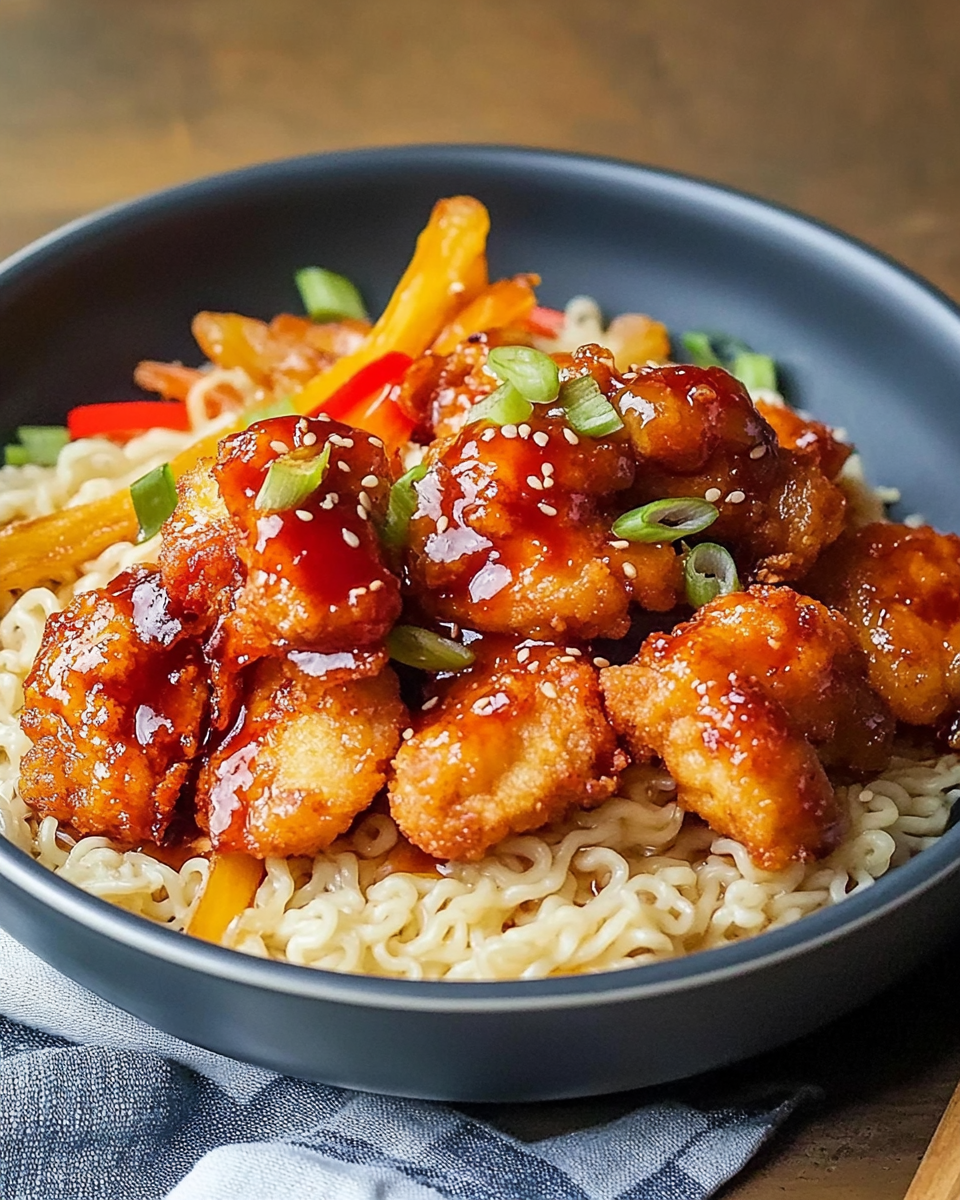Baked sweet and sour chicken is a popular dish that brings a delightful blend of flavors and textures to the table. It is a beloved favorite in many households, often found on the menus of Chinese restaurants around the world. This dish combines tender pieces of chicken, a tangy sauce, and vibrant vegetables, creating a colorful and appetizing meal. In this article, we’ll explore the origins of sweet and sour chicken, its nutritional benefits, variations, and tips for perfecting this dish at home.
Full Recipe:
Ingredients
For the Chicken:
- 1 lb (450g) boneless, skinless chicken breasts, cut into bite-sized pieces
- 1/2 cup cornstarch
- 1 egg, beaten
- 1 tablespoon vegetable oil
- Salt and pepper, to taste
For the Sauce:
- 1/2 cup granulated sugar
- 1/3 cup apple cider vinegar
- 1/4 cup ketchup
- 1 tablespoon soy sauce
- 1 teaspoon garlic powder
- 1 teaspoon onion powder
- 1 teaspoon cornstarch mixed with 2 tablespoons water (for thickening)
For Baking:
- 1 bell pepper (red or green), cut into chunks
- 1 cup pineapple chunks (fresh or canned, drained)
- Cooked rice, for serving
Instructions
- Preheat the Oven: Preheat your oven to 375°F (190°C).
- Prepare the Chicken:
- In a bowl, mix the cornstarch with a little salt and pepper.
- Dip the chicken pieces into the beaten egg, then coat with the cornstarch mixture.
- In a large baking dish, toss the coated chicken pieces with vegetable oil to coat evenly.
- Bake the Chicken:
- Bake the chicken in the preheated oven for about 25-30 minutes, flipping halfway through, until golden and cooked through.
- Make the Sauce:
- While the chicken is baking, combine the sugar, apple cider vinegar, ketchup, soy sauce, garlic powder, and onion powder in a saucepan over medium heat.
- Bring the mixture to a simmer, stirring until the sugar dissolves.
- Add the cornstarch-water mixture and cook for another minute or two until the sauce thickens. Remove from heat.
- Combine Everything:
- After the chicken is done baking, remove it from the oven and pour the sauce over it.
- Add the bell pepper and pineapple chunks, stirring gently to combine.
- Return to the oven and bake for an additional 10-15 minutes, until the peppers are tender.
- Serve: Serve the sweet and sour chicken over cooked rice. Enjoy!
Tips:
- You can add other veggies like broccoli or snap peas for more color and nutrition.
- If you prefer a crunchier texture, consider frying the chicken instead of baking it.
The Origins of Sweet and Sour Chicken
Sweet and sour chicken has its roots in traditional Chinese cuisine, specifically in the Cantonese region. The dish is known for its distinctive combination of sweet and tangy flavors, which are achieved through a variety of ingredients, including vinegar, sugar, and fruit. Historically, the combination of sweet and sour flavors was used to enhance the taste of meats, making them more palatable and enjoyable.
The concept of balancing flavors is not unique to Chinese cuisine; many cultures incorporate similar principles in their cooking. However, the popularity of sweet and sour chicken in Western countries can be attributed to the adaptations made by Chinese immigrants in the United States during the 19th and 20th centuries. The dish evolved to cater to Western tastes, leading to the sweet and sour chicken we know today, often featuring crispy chicken pieces coated in a thick, syrupy sauce.
Nutritional Benefits
Baked sweet and sour chicken can be a nutritious meal option when prepared with the right ingredients. Chicken breast is an excellent source of lean protein, which is essential for muscle repair and growth. It is also low in fat, making it a healthier choice compared to other meats.
The addition of vegetables such as bell peppers and pineapple not only enhances the dish’s flavor but also contributes essential vitamins and minerals. Bell peppers are rich in vitamins A and C, both of which support immune function and skin health. Pineapple adds a tropical sweetness while providing bromelain, an enzyme known for its anti-inflammatory properties.
The sauce, while sweet and tangy, can be modified to reduce sugar content or substitute healthier alternatives, such as honey or agave syrup. This allows for a more balanced dish that fits into various dietary needs without sacrificing flavor.
Variations on the Classic Recipe
One of the joys of cooking is the ability to adapt and customize recipes according to personal preferences. Baked sweet and sour chicken is no exception. Here are a few variations you might consider:
- Protein Alternatives: While chicken is the classic choice, you can easily substitute it with other proteins such as tofu for a vegetarian version, or shrimp for a seafood twist. Both options can absorb the sweet and sour flavors beautifully.
- Vegetable Additions: Feel free to incorporate other vegetables to enhance the dish’s nutritional profile and visual appeal. Broccoli, snap peas, carrots, and onions can all be excellent additions that add texture and color.
- Fruit Variations: While pineapple is commonly used, you can experiment with other fruits. Mango, for instance, offers a tropical sweetness that pairs well with the tangy sauce. Adding fruit can also enhance the dish’s nutritional value.
- Different Sauces: If you’re looking for a twist, consider trying a different sauce base. A ginger or chili-infused sauce can add depth and heat, while a teriyaki sauce can provide a different flavor profile.
- Spicy Version: For those who enjoy a kick, adding red pepper flakes or sriracha to the sauce can turn up the heat, creating a spicy-sweet sensation that tantalizes the taste buds.
Tips for Perfecting Baked Sweet and Sour Chicken
Achieving the perfect baked sweet and sour chicken involves a few key techniques:
- Coating the Chicken: For a crispy texture, make sure to coat the chicken pieces evenly in cornstarch before baking. This helps to create a crispy exterior that holds up well against the sauce.
- Baking Time and Temperature: Proper baking is crucial. Baking at the right temperature ensures that the chicken cooks through without drying out. Flipping the chicken halfway through the cooking time promotes even browning and ensures all sides become crispy.
- Sauce Consistency: The sauce should be thick enough to cling to the chicken but not so thick that it becomes gloppy. Adjusting the amount of cornstarch in the sauce can help you achieve the desired consistency. Always taste and tweak the sauce as needed before adding it to the chicken.
- Serving Suggestions: Serving sweet and sour chicken over a bed of fluffy rice not only complements the dish but also helps soak up the flavorful sauce. Consider offering side dishes like steamed vegetables or a fresh salad to round out the meal.
Conclusion
Baked sweet and sour chicken is more than just a delightful dish; it’s a culinary experience that combines tradition, nutrition, and creativity. With its origins rooted in Chinese cuisine and its evolution into a staple in many homes, this dish has proven to be versatile and beloved by many.
By using fresh ingredients and allowing for personal adaptations, you can make sweet and sour chicken that suits your taste and dietary needs. Whether you enjoy the classic version or choose to explore variations with different proteins and vegetables, the fundamental appeal of sweet and sour chicken remains the same: a harmonious balance of sweet, tangy, and savory flavors.
So next time you’re looking for a satisfying meal that’s both easy to prepare and bursting with flavor, consider making baked sweet and sour chicken. It’s sure to become a favorite in your kitchen, bringing joy and satisfaction to your dining table. Enjoy the process of cooking, and don’t hesitate to experiment with this versatile recipe!






